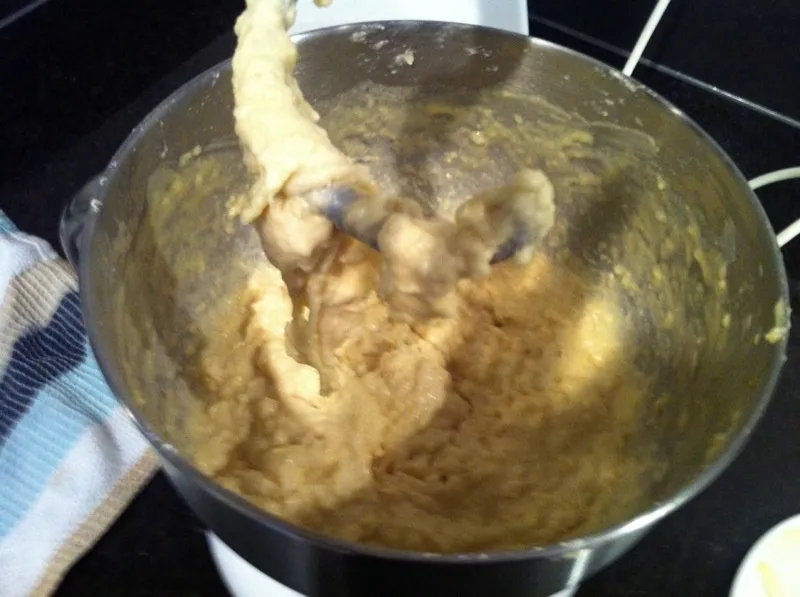
My recipe for sweet buns called for 550 grams of flour and 300 grams of milk.
I took 30 grams of flour and 150 grams of milk (scalded) to make a roux (which ended up about 125 grams when it was done).
The remaining 520 grams of flour was mixed with the remaining 150 grams for milk (scalded). I was trying to autolyse. However, at just 28% hydration (it's actually less since milk is not 100% water), the resulting dough was very dry and flaky. So ... I decided to add another 150 grams of milk (scalded), 50 grams at a time, to get a ball looking dough. I left the autolyse for about one hour.
I then combined the 125 grams of roux, 2 eggs, salt, sugar, 75 grams butter, and yeast mixed with an additional 30 grams of water (for proofing).In all, I added a total of 180 grams of additional liquid to the recipe (150 grams milk, 30 grams water for proofing).
As everything mixed in the mixer, I knew it would probably end up being very wet. However, I also noticed that the dough from the autolyse didn't really incorporate well. At first, it seemed like the ball of dough wasn't going to mix at all. I helped it a bit with a spatula, and then it started to mix better. But in the end, I still saw small chunks of the dough in what almost looked like a batter (I was expecting a batter like texture knowing that I added extra liquid, but I thought it would be smooth).
I'll be making modifications to the recipe based on this experiment of mine (e.g. maybe switch to powder milk or don't try combining roux + autolyse). However, I'm curious, is milk actually OK in a roux and autolyse? Did the fact that I used milk in the autolyse cause a batter that's not smooth (perhaps something to do with the protein in the milk + gluten development)?
autolyse. 28% water won't autolyse much of anything and will just make a hard lump of paste that you won't be able to incorporate well later. Once the eggs, salt and butter go in you can do a final check to see if it needs more milk. 55 g of liquid was lost when you made the roux so adding that much milk at the end wouldn't be out of line at all.
Happy baking
So adding the roux in the autolyse is OK? I was worried that this might somehow cancel the benefits of either the roux or the autolyse.
Note that the autolyse was not 28%. I kept adding more milk -- 150 grams in total -- until I got something that resembled a dough ball.
So what do you think accounts for the clumps? If I got the hydration I needed (or more), shouldn't I have gotten a nice dough (or batter if too hydrated)?
If you would have beat it with the paddle first and then switched to the dough hook then it would have been fine,Adding an additional 150 g of milk rather than 55 was probably not a good choice since the dough got soupy and made it even less likely to incorporate. Everything is easier in hindsight. You can and should put the roux in the autolyse. By the time it is mixed in, it doesn't know what it once was - in either the autolyse or dough, the roux disappears.
Happy Baking
My experiment actually deals with combining the water roux and autolyse technique to see how it fairs. I don't bake often and have never tried either techniques. Perhaps I should try roux only, autolyse only, and roux + autolyse. I'm starting with roux + autolyse first, though. Will I see double the benefits in terms of softness and moistness?
The lumps look as if the flour and the butter have been clumped together and not mixed very well, maybe you should have used the paddle first until it got smooth and than the dough hook.
So the problem is possibly technique? Is paddle attachment generally used first after an autolyse?
It could be a problem that you used the dough hook because the dough hook is not very good when you have a very liquid mass.
When I use my Stand Mixer I do use the paddle first to incorporate everything and than I use the Doug hook.
I do not use the Stand Mixer very often though, I much prefer to use my hands , that is how I got to know how dough at any stage feels like or * should * feel like.
This is a tricky dough (brioche base with a roux) with a specific process that works for combining ingredients. I would guess that two things happened to create your lumps: first, you didn't have enough of the final ingredients in the dough when you autolysed and so when gluten started to form, it made it difficult to mix in so much "stuff". Consider using eggs, roux, etc. as part of the liquid for the autolyse (but not salt or butter). Second, the butter in this type of dough has to be very soft and has to be added a little at a time and the dough kneaded until each bit is incorporated before adding more. You don't specify your process but it looks as though you didn't follow that technique.
If you're looking for a fully tested recipe for a sweet bun of this type, I've posted one here on TFL (TZ Milk and Honey Sweet Dough): http://www.thefreshloaf.com/node/38087/ultimate-cinnamon-rolls
Either way, have fun baking!